British Congress of Mathematics Education 9
3rd – 6th April 2018 at University of Warwick
An exciting time at my first Maths Conference, throwing myself in at the deep end with 300 sessions to choose from and a complex campus to navigate quickly. Lots of problem solving fun from the start as there were no signs to session rooms – 1. Choose session & note reference 2. Cross check to building & room reference 3. Refer to campus map; estimate time to building & allow plenty of time to find the room (must have done numerous circuits of the humanities block) 4. Don’t get caught in deep conversation with anyone beforehand. Impressive how few delegates were lost or late! We must be mathematicians.
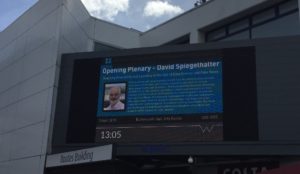 The Opening Plenary by David Spiegelhalter reminded us of the importance of data literacy for students. We were set some challenging questions. I particularly enjoyed the one about the 1000 Athletes which I can now revisit in ‘Teaching Probability’ by Jenny Gage & David Spielgelhalter p6 and the 1µg/kg/day caffeine question here. Also, I found the reinforcement of the use of actual values of 100, 1000 to analyse problems a reassuring reminder as it is rarely seen in text books or questions, although I often use it with students and they look quite mystified. Flipping statistics round to find a different viewpoint was another useful skill; flip 99% to 1% for example and consider actual values. This all comes at a time of pivotal change in the A Level Maths syllabus with the introduction of the Large Data Set. It will be interesting to see how this helps students data literacy.
The Opening Plenary by David Spiegelhalter reminded us of the importance of data literacy for students. We were set some challenging questions. I particularly enjoyed the one about the 1000 Athletes which I can now revisit in ‘Teaching Probability’ by Jenny Gage & David Spielgelhalter p6 and the 1µg/kg/day caffeine question here. Also, I found the reinforcement of the use of actual values of 100, 1000 to analyse problems a reassuring reminder as it is rarely seen in text books or questions, although I often use it with students and they look quite mystified. Flipping statistics round to find a different viewpoint was another useful skill; flip 99% to 1% for example and consider actual values. This all comes at a time of pivotal change in the A Level Maths syllabus with the introduction of the Large Data Set. It will be interesting to see how this helps students data literacy.
So thrilled to feel at home🏡 in the first session with Polyhedron nets with an inspiring talk from Mr Ian Hibbert of Oswestry School ‘Bridging the divide between Primary & Secondary Schools’.
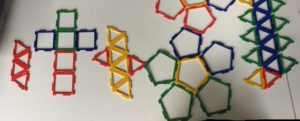 Just a few of the techniques we considered to ease the transition of students from Primary to Secondary were: 1. 3D shapes & patterns using Geomag or Polyhedron, Ian completed a fantastic 4D cube in 3D. 2. Fibonacci numbers use real life representations; rabbits, flowers… (tied in nicely with Tom Roper’s MA Presidential address too). 3. Cross curricula; use the Periodic Table for some cryptography, musical notes for fractions. All enough to make any students settle well into the secondary Maths classroom. Coincidentally I met Sandie Blakesley, at the same session. She is publications officer at ATM who I have only previously met in the virtual world! collaborating on a seasonal resource – great to meet you in person Sandie.
Just a few of the techniques we considered to ease the transition of students from Primary to Secondary were: 1. 3D shapes & patterns using Geomag or Polyhedron, Ian completed a fantastic 4D cube in 3D. 2. Fibonacci numbers use real life representations; rabbits, flowers… (tied in nicely with Tom Roper’s MA Presidential address too). 3. Cross curricula; use the Periodic Table for some cryptography, musical notes for fractions. All enough to make any students settle well into the secondary Maths classroom. Coincidentally I met Sandie Blakesley, at the same session. She is publications officer at ATM who I have only previously met in the virtual world! collaborating on a seasonal resource – great to meet you in person Sandie.
Finished the day attending the ATM AGM as a proud member for the first time and hear about all the hard work going on behind the scenes. Again meeting someone I only previously communicated with through cyberspace, Kerry Hamilton Executive Officer who has been so encouraging of my resources – hope to catch up again at a less hectic event Kerry. You & the team did an amazing job.
There were plenty more evening activities to attend! Hats off to the ‘Maths Jammers’ but I was glad to get back to the hotel & put my feet up & listen to ‘Takeaways 1‘ – ‘Flipping heck do they never stop’.
Day 2 up bright & early for a session on ‘Collaborative Maths and the power of a growth mindset’ by Simon Ayres, Director of Studies at Barnard Castle Prep School. A helpful visual of ‘The Iceberg Illusion’ showing what we see ‘success’ and what we don’t see ‘hard work, failure, persistence, sacrifice, dedication, good habits, disappointment’. Particularly touching that Simon shared a special quote ‘Don’t practise until you are right, practise until you are not getting it wrong’ from a very mature young lady – thank you for sharing. Fascinating to hear of a school that has adopted a Growth Mindset and the steps taken to encourage this not least presenting these tips to the parents. More lovely puzzles, here is one that was done as a team after I failed to achieve it on my own.
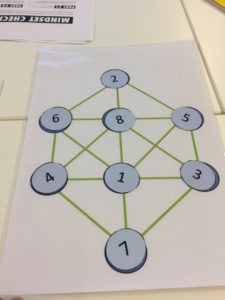 A quick ten minute change of buildings to hear Karen Skilling report on her research ‘Differences in teacher beliefs and practices for promoting cognitive engagement in Mathematics’. Fascinating to look into the cognitive engagement (or not) of students ‘what are they actually thinking and how do we find out’? My takeaways were; ask the students what they are thinking, plan your lesson but also plan for student engagement, give your students choice so they have some autonomy.
A quick ten minute change of buildings to hear Karen Skilling report on her research ‘Differences in teacher beliefs and practices for promoting cognitive engagement in Mathematics’. Fascinating to look into the cognitive engagement (or not) of students ‘what are they actually thinking and how do we find out’? My takeaways were; ask the students what they are thinking, plan your lesson but also plan for student engagement, give your students choice so they have some autonomy.
Time for a coffee break and the extensive Publishers’ Exhibition. Another great opportunity to meet contacts face to face, in particular Will Hornby of the OCR Maths Team; thank you for all your helpful resources and advice.
On to the MA Presidential address, Tom Roper ‘Adventures in Shape, Space & Time’. A great reminder to adopt cross curricula and use Maths included in other subjects; surface area to volume in Biology, interaction of two cities in Geography, how fast can you walk? using Physics. The Penguin huddle was adorable and a great example of the power of community.
Lunch break and time for a bite to eat and pick up some useful resources & tips from exhibitors. Somewhere on Twitter I picked up that The Cuisenaire Team were exhibiting, the hunt was on & I found them behind a crowd of interested delegates – clearly Cuisenaire rods are making a huge come back. It made my day to meet the granddaughter of Gattegno, Michaela, and share the resource that led me to all things Maths (Those are my cuisenaire rods in the picture! The number of times they escaped the cull on a bedroom clear out).
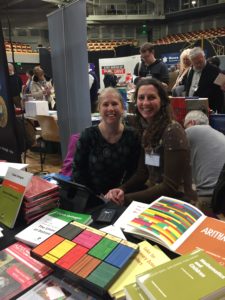 Appropriately I headed off to my next session ‘Gattegno (30th Anniversary): Cuisenaire rods’ by Ian Benson and Anne Crosby. The newest takeaway for me was the link with coding: here is a picture courtesy of J O’Bryne
Appropriately I headed off to my next session ‘Gattegno (30th Anniversary): Cuisenaire rods’ by Ian Benson and Anne Crosby. The newest takeaway for me was the link with coding: here is a picture courtesy of J O’Bryne
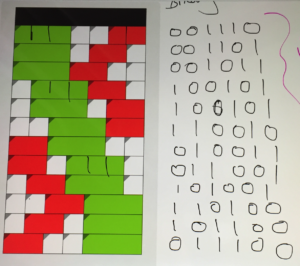 I challenge you to work out the coding from the pattern. Looking forward to seeing the reordered pattern JB.
I challenge you to work out the coding from the pattern. Looking forward to seeing the reordered pattern JB.
The last session of the day, ‘Using Art in the Mathematics Classroom’ by Clarissa Grandi was perfectly timed for some maths art therapy. After a colourful and inspirational introduction we were allowed to create our own piece of art – the tranquility of the room was blissful.
Here is my creation, ‘A Bug Chase’.
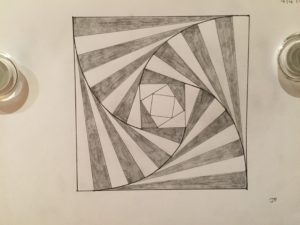 Finished the day at the MA AGM, again proud to be attending for the first time and hear of more hard work behind the scenes. I particularly appreciated the Treasurer’s report which was presented with great clarity. Thanks to David Miles.
Finished the day at the MA AGM, again proud to be attending for the first time and hear of more hard work behind the scenes. I particularly appreciated the Treasurer’s report which was presented with great clarity. Thanks to David Miles.
At 7pm it was time for me to sign out and drive home in the dark rainy night, two days was quite enough for a first timer. It was well worth the effort and thoroughly enjoyed keeping up with the conference via ‘The Takeaways‘ from Mr Barton & Jo Morgan. Looking forward to challenging my A Level students with the ‘Quartic’ real roots question and the identify the f(x), f ‘(x) & ∫f(x) .dx graph question.
Met some great new colleagues; Gina thanks for asking ‘what advice I would give a trainee?’ I have never been asked before & it was a privilege to share some of my best bits. I sensed your enthusiasm and wish you all the best for the completion of your training year at Loughborough. Fliss, love that name, hope those early years students appreciate all the great things you will be taking back for them and I am looking forward to an easy time of it in the later years. Martin great to see your Art work blossom. Rob, thanks for being so welcoming and sharing your sweets.
Most repeated phrase ‘let them struggle & fail but not too long’
Best Bit ‘Cuisenaire‘
Thank you to all the BCME Committee for an enjoyable, informative and well run conference.
Written by J Forsythe. Any misrepresentations, errors or omissions please let me know at [email protected]
